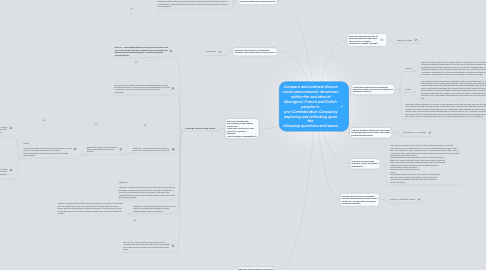
1. Who were the key figures in the French exploration and settlement of North America?
1.1. Key people of New France
2. What roles did the Royal Government and the Catholic Church play in the social structure of New France (i.e., governor, intendant, Jesuits, religious congregations)?
2.1. Sovereign Council of New France
2.1.1. King XIV The king was highest official in France but in New France he couldn't be there all the time so he appointed the governor to be his representative. The king choose the representatives.
2.1.2. Governor The Governor was the king's representative and was the highest official in New France. He had the biggest say in the Sovereign Council. The first governor was Samuel de Champlain.
2.1.3. Intendant The intendant was in charge of day to day affairs like the courts, roads etc.
2.1.3.1. Bishop The bishop was the head of the church and had a big say in politics.
2.1.3.1.1. Priests The priest was the second most important person in the church. The priest helped the nuns and the missionaries teach the schools, helped the poor and the churches.
2.1.4. Seigneurs The king used the seigneurial system for the social structure. The king gave a seigneur a large amount of land and the seigneur's job was to find people to rent a small part of the land. The habitant (person living in the land) had to give some of the crops grown and pay fees.
2.1.5. Habitants The Habitants are the citizens of New France. The people that settled here were considered the original Canadiens.
2.1.5.1. Children The girls got the better education since most schools only taught girls. All children had more of a chance to go to school than they did in France because they needed to help their families. The curriculum for the school was based around their Catholic religion since the nuns taught the schools.
2.1.6. Filles du roi Very few woman wanted to live in an unknown land and marry the men so the King brought 900 single woman to New France so the town could grow.
3. Who were the key figures in the British exploration and settlement of North America?
3.1. Key People
4. What role did the British government play in the settlement of North America?
4.1. The British sent much more people to explore the area and settle into colonies. When the 13 colonies started 90,000 people were habitants and in 100 years, the population grew 1.5 million people. At New France in the same time, the population started at 3,000 people and in 100 years the population only grew to 61,000 people. The british were much more focused to build and grow a colony in North America.
5. What were the different ways in which Aboriginal societies were structured (i.e., Iroquois, Confederacy, Ojibwa, Mi’kmaq)?
5.1. Blackfoot Culture
6. How did the structures of Aboriginal societies affect decision making in each society (i.e., role and status of women, consensus building)?
6.1. Iroquois, Mi'kmaq and Ojibwa
7. What were the social and economic factors of European imperialism?
7.1. They set up colonies for the resources that North America had. This was untouched land. In Europe there was a craze for beavers because they made hats out of the skins. After all the beavers in Europe were extinct, they came to Canada for more. That's why the Europeans traded with the first nations, metals and guns in exchange for skins. The countries in Europe were usually always at war with each other so to prove that this country was more powerful than the other, they set up colonies to show prestige. They also brought resources to Europe since they was a growing demand. The Europeans were curious on what was on the other side of the world. Christianity was the most common religion in Europe but their was other religions like Catholics and Protestants. Most of the Europeans wanted to spread Christianity around the world.
8. In what ways did European imperialism impact the social and economic structures of Aboriginal societies?
8.1. French
8.1.1. When the French first came to Canada, what is now Quebec, the first nations were upset with how the Europeans thought that all the land was for themselves when it wasn't. The first nations would allow the French to share the land, as long as the Europeans didn't interfere with their tradtions and way of life. Jacques Cartier captured one of the first nations tribes chief named Donnacona and his sons, to show that the French and good people and can be trusted. Donnacona never made back home, so a tribe was left without a leader.
8.2. British
8.2.1. John Cabot found a fishing post on the east coast near Newfoundland. A first nation tribe called the Beothuk lived in Newfoundland in that time period and their daily lifes' were very dependant on fish. Since the Europeans were so crazed to get all the fish in the area they blocked the Beothuk's way to get to the shore. After the Europeans left in the winter, the Beothuk sabotaged the fishing stations to have access to the fish. When the British came back to Newfoundland, they were unhappy about what the Beothuk did so the British killed all the Beothuk. The Europeans brought diseases that killed even more of the first nations. The British killed a nation just for resources. This wasn't even their land, it belonged to the Beothuk and the tribe would most likely have let the British use the land but not like this.
